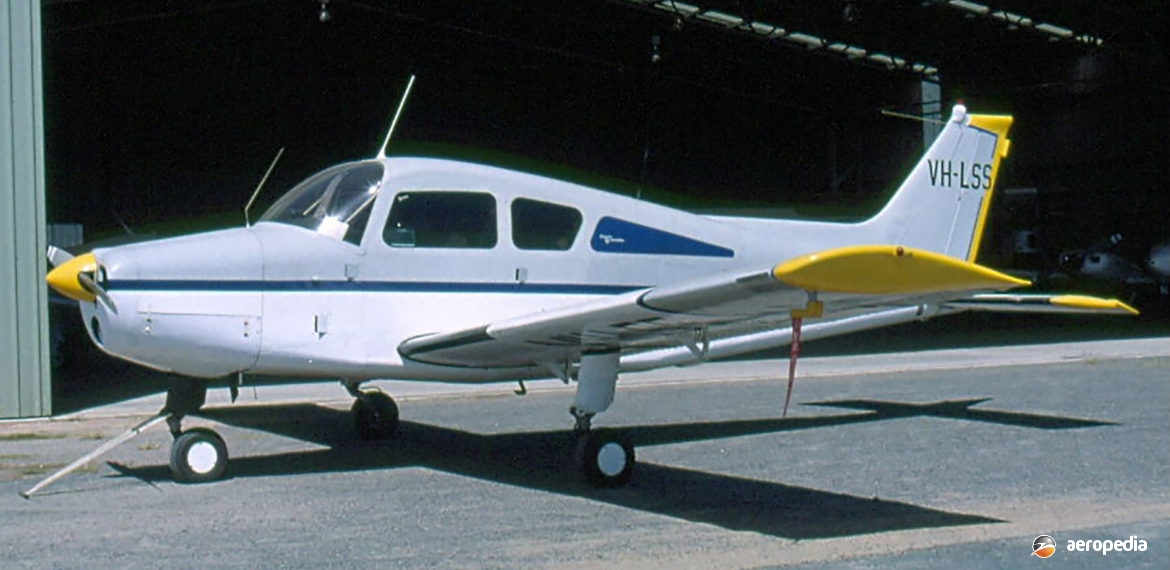Photograph:
Beech 23 Musketeer VH-LSS (c/n M-353) at Bankstown, NSW in October 1990 (David C Eyre)
Country of origin:
United States of America
Description:
Four-seat cabin monoplane
Power Plant:
One 123 kw (165 hp) Continental IO-346-A four-cylinder horizontally-opposed air-cooled engine
Specifications:
- Wingspan: 10 m (32 ft 9 in)
- Length: 7.6 m (25 ft)
- Height: 2.5 m (8 ft 3 in)
- Wing area: 13.6 m² (146 sq ft)
- Max speed: 235 km/h (146 mph)
- Max cruising speed at 2,134 m (7,000 ft): 220 km/h (137 mph)
- Stalling speed: 93 km/h (58 mph)
- Initial rate of climb: 225 m/min (728 ft/min)
- Service ceiling: 3,618 m (11,870 ft)
- Range with max fuel: 1,458 km (906 miles)
- Empty weight: 624 kg (1,375 lb)
- Loaded weight: 1,089 kg (2,400 lb)
History:
The prototype of the Beech 23 Musketeer series of light four-seat cabin monoplanes was flown for the first time on 23 October 1961, and was introduced to the Beechcraft range in 1962. Known as the Model 23 Musketeer I, the first production version employed bonded aluminium honeycomb construction in its wings, and was powered by a 119 kw (160 hp) Lycoming O-320-B2C engine. Some 500 examples of this model were built.
In 1964 a new model, the A23 Musketeer II, appeared after the prototype had been flown during the previous year. Resulting from a re-appraisal of the design, this new model had more extensive cabin glazing, an increased landing flap angle, and a 123 kw (165 hp) Continental IO-346-A fuel-injected engine. In 1965 a new model, known as the Model B23 Musketeer III, appeared. Basically, it was a developed version of the Musketeer II, to be offered in three basic versions, and advertised as ‘The Three Musketeers’.
These variants comprised the Custom III, a middle of the range model which replaced the Musketeeer II and was powered by a 123 kw (165 hp) Continental IO-360-A engine; the Super III, a deluxe version of the Custom III with more standard equipment, which was powered by a 149 kw (200 hp) Lycoming IO-360-A1A engine; and the Sport, a cheaper training and sport version powered by a 112 kw (150 hp) Lycoming O-320-E2C engine. The Sport differed externally from the others in having only two side cabin windows, whereas the other models had three.
In 1970 Beech re-designed the Musketeer fuselage to be more rounded, thus providing more cabin room. In 1972 the names of the aircraft in the range were changed, the ‘Musketeer’ name was dropped, and the Custom became known as the Sundowner. At this time all models became available with an Edo-Air Mitchell Century auto-pilot, and the fuel capacity was increased to 216 litres (47 Imp gal). All versions were fitted with a fixed tricycle undercarriage. An aerobatic version approved to perform rolls, Immelmann turns, loops, spins, chandelles, etc, was also produced.
In 1970 a retractable undercarriage version (in fact the Custom III powered by a 149 kw [200 hp] engine) was added to the range, and became known as the Super R. When the names were changed in 1972, the Super R became the Sundowner, and the fixed undercarriage 149 kw (200 hp) model was dropped from the line. The model with retractable undercarriage was then offered in two versions, the Sundowner and the Sierra, the latter having a fuel-injected engine.
By 1980 the range comprised the Sundowner with a fixed undercarriage and a 134 kw (180 hp) engine, and the Sundowner Sport which was replaced in the range by the Skipper. Production of the series was suspended in 1984 after a total of 4,455 examples of all models had been built. Seventy examples have appeared on the Australian register and seven on the New Zealand register.

